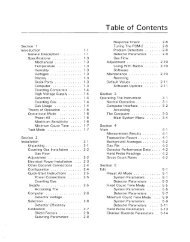Gilson and Voss - Voss Associates
Gilson and Voss - Voss Associates
Gilson and Voss - Voss Associates
You also want an ePaper? Increase the reach of your titles
YUMPU automatically turns print PDFs into web optimized ePapers that Google loves.
5. Air-proportional alpha detectors have a flatter energy vs<br />
efficiency response than sealed gas-proportional, alpha<br />
scintillator, alpha/beta scintillator, or GM detectors. This is<br />
due to several factors. One factor is the typically thinner<br />
entrance windows on air-proportional alpha detectors<br />
compared to beta detectors <strong>and</strong> alpha <strong>and</strong> beta scintillator<br />
detectors whereby more of the initial alpha particle energy<br />
enters the active volume of the air-proportional compared to<br />
other detectors. A second factor is the relatively shallow<br />
depth of the air-proportional detector compared to the path<br />
length of the alpha particle in air which leads to the alpha<br />
pulses being of similar height for any alpha particle energy<br />
above a threshold.<br />
6. Alpha particle energy transfer to air<br />
6 MeV alpha particles produce 40,000 Ion Pairs per cm<br />
4 MeV alpha particles produce 55,000 Ion Pairs per cm<br />
ù for air is 34 eV per Ion Pair<br />
therefore;<br />
6 MeV alpha particles lose 1.18 MeV per cm of air<br />
4 MeV alpha particles lose 1.87 MeV per cm of air<br />
Alpha particle range in cm of air at 1 atmosphere<br />
R<br />
a<br />
= 0.56 E (E 4 MeV)<br />
a<br />
Alpha particles lose about 60 KeV of energy per mm of air<br />
at STP.<br />
5. Air-proportional alpha detectors have a flatter energy vs<br />
efficiency response than sealed gas-proportional, alpha<br />
scintillator, alpha/beta scintillator, or GM detectors. This is<br />
due to several factors. One factor is the typically thinner<br />
entrance windows on air-proportional alpha detectors<br />
compared to beta detectors <strong>and</strong> alpha <strong>and</strong> beta scintillator<br />
detectors whereby more of the initial alpha particle energy<br />
enters the active volume of the air-proportional compared to<br />
other detectors. A second factor is the relatively shallow<br />
depth of the air-proportional detector compared to the path<br />
length of the alpha particle in air which leads to the alpha<br />
pulses being of similar height for any alpha particle energy<br />
above a threshold.<br />
6. Alpha particle energy transfer to air<br />
6 MeV alpha particles produce 40,000 Ion Pairs per cm<br />
4 MeV alpha particles produce 55,000 Ion Pairs per cm<br />
ù for air is 34 eV per Ion Pair<br />
therefore;<br />
6 MeV alpha particles lose 1.18 MeV per cm of air<br />
4 MeV alpha particles lose 1.87 MeV per cm of air<br />
Alpha particle range in cm of air at 1 atmosphere<br />
R<br />
a<br />
= 0.56 E (E 4 MeV)<br />
a<br />
Alpha particles lose about 60 KeV of energy per mm of air<br />
at STP.<br />
Page 125<br />
Page 125<br />
5. Air-proportional alpha detectors have a flatter energy vs<br />
efficiency response than sealed gas-proportional, alpha<br />
scintillator, alpha/beta scintillator, or GM detectors. This is<br />
due to several factors. One factor is the typically thinner<br />
entrance windows on air-proportional alpha detectors<br />
compared to beta detectors <strong>and</strong> alpha <strong>and</strong> beta scintillator<br />
detectors whereby more of the initial alpha particle energy<br />
enters the active volume of the air-proportional compared to<br />
other detectors. A second factor is the relatively shallow<br />
depth of the air-proportional detector compared to the path<br />
length of the alpha particle in air which leads to the alpha<br />
pulses being of similar height for any alpha particle energy<br />
above a threshold.<br />
6. Alpha particle energy transfer to air<br />
6 MeV alpha particles produce 40,000 Ion Pairs per cm<br />
4 MeV alpha particles produce 55,000 Ion Pairs per cm<br />
ù for air is 34 eV per Ion Pair<br />
therefore;<br />
6 MeV alpha particles lose 1.18 MeV per cm of air<br />
4 MeV alpha particles lose 1.87 MeV per cm of air<br />
Alpha particle range in cm of air at 1 atmosphere<br />
R<br />
a<br />
= 0.56 E (E 4 MeV)<br />
a<br />
Alpha particles lose about 60 KeV of energy per mm of air<br />
at STP.<br />
5. Air-proportional alpha detectors have a flatter energy vs<br />
efficiency response than sealed gas-proportional, alpha<br />
scintillator, alpha/beta scintillator, or GM detectors. This is<br />
due to several factors. One factor is the typically thinner<br />
entrance windows on air-proportional alpha detectors<br />
compared to beta detectors <strong>and</strong> alpha <strong>and</strong> beta scintillator<br />
detectors whereby more of the initial alpha particle energy<br />
enters the active volume of the air-proportional compared to<br />
other detectors. A second factor is the relatively shallow<br />
depth of the air-proportional detector compared to the path<br />
length of the alpha particle in air which leads to the alpha<br />
pulses being of similar height for any alpha particle energy<br />
above a threshold.<br />
6. Alpha particle energy transfer to air<br />
6 MeV alpha particles produce 40,000 Ion Pairs per cm<br />
4 MeV alpha particles produce 55,000 Ion Pairs per cm<br />
ù for air is 34 eV per Ion Pair<br />
therefore;<br />
6 MeV alpha particles lose 1.18 MeV per cm of air<br />
4 MeV alpha particles lose 1.87 MeV per cm of air<br />
Alpha particle range in cm of air at 1 atmosphere<br />
R<br />
a<br />
= 0.56 E (E 4 MeV)<br />
a<br />
Alpha particles lose about 60 KeV of energy per mm of air<br />
at STP.<br />
Page 125<br />
Page 125













